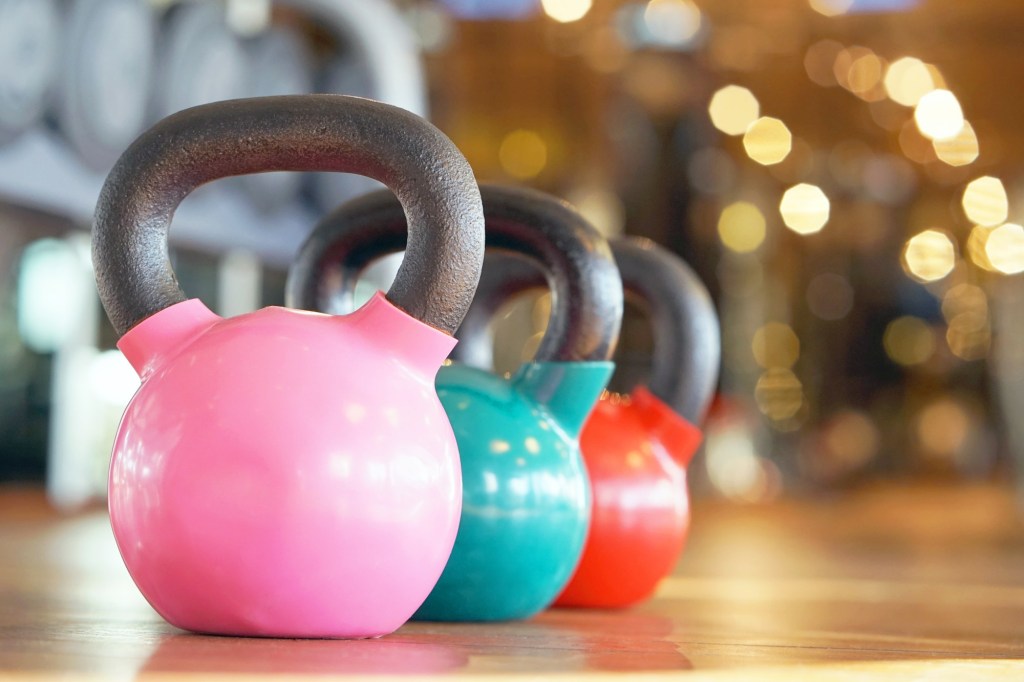
By Teddy Amenabar
The Washington Post
Todd VanKerkhoff doesn’t have much time to exercise. The 34-year-old internal medicine physician in Chicago has three young kids. So for workouts, he often uses kettlebells in his backyard.
“Crushed this kettlebell workout while my 2 year old watched Mickey Mouse,” he recently wrote on Instagram.
VanKerkhoff is among the many busy dads who are turning to kettlebells, which look like cannonballs with handles, to get in their workouts. VanKerkhoff said he started using the weights when he had a “crazy” schedule working nights during the pandemic, with not a lot of time to exercise. Now, he says kettlebells make up the bulk of his training.
“You don’t need a gym,” said VanKerkhoff, who posts his workouts as “dr._dadbod.” “You just need one chunk of iron to get a good workout for the day and get stronger.”
Kettlebells are beloved by fans because the simple weights can be held in various ways to quickly conduct full-body workouts. Fitness instructors who regularly train with kettlebells say the weights appeal to people who are looking for short and dynamic strength-training routines that can also raise their heart rate.

“People choose kettlebells because then you don’t need to build out a whole home gym,” said Samantha Ciaccia, the founder of Bell Mechanics, which offers training for fitness instructors and kettlebell enthusiasts. “That takes money, that takes space.”
Cameron Martin, a 36-year-old father of three who also posts kettlebell workouts from his backyard on Instagram, said many of his followers consist of 30-to-50-year-old men and women juggling long hours at work while parenting their kids.
“The emails don’t stop and kids are doing more than they ever have,” Martin said. “We know we need to be healthy. We also know we have very limited time and resources.”
The perks of using kettlebells
Machines at the gym often move in fixed positions and work one muscle group at a time, said Adriell Mayes, a fitness trainer in Boston. With kettlebells, you can do more complex movements, such as starting with a squat that works the legs and then transitioning into a thruster – pushing the weight above your head to strengthen your arms and shoulders.
“If you have a full set of bells,” Mayes said. “you really don’t need anything else.”

Compared with dumbbells, VanKerkhoff said, kettlebells feel “more comfortable and stable.” A dumbbell’s weight is distributed to two sides, which can create “two teetering ends” balancing on your wrist, he said.
Lester Marbury, a 28-year-old dad whose handle on Instagram is @dopekettlebelldad, said he can set a timer for 15 minutes and still get a good kettlebell workout in.
“It’s only 15 minutes compared to an hour, driving to the gym, getting set up and everything,” said Marbury, who lives in Laurel, Maryland. “And it’s right here in the house.”
Plus, kettlebell exercises mimic the moves already required of dads.
“Picking up one of my daughters and throwing her in the air is like doing a kettlebell squat into a thruster,” said Brad Simpson, a 38-year-old father who lives in Cincinnati. “It mimics that real-life thing I do with my kids all the time.”
How to pick the right kettlebells for you
Before you buy your own kettlebells, it’s a good idea to test out different weights at a gym, Martin said. This way, you can pick the ideal weights for your level of strength.
Brett Jones, the director of education at StrongFirst, a strength-training school with a certification program in kettlebell training, said that if you can buy only one weight, pick a kettlebell you can press overhead.
Just make sure it’s not too heavy.
“In the beginning, you’re going to be focusing on your form and how your body moves,” Mayes said. “That matters before you start adding weight.”
If you can invest in three or more kettlebells, pick a lighter weight you can press over your head, a medium weight for squats and a heavier weight for deadlifts, Ciaccia said.
3 kettlebell exercises for beginners
You can use kettlebells for basic strength exercises — such as squats, rows and presses — as well as more “ballistic” movements, such as swings and snatches, which require swinging the weight with momentum.
Using the proper form is key to avoid getting injured during a kettlebell workout, especially when doing ballistic movements. If you can, work with an instructor trained in kettlebells to learn the different exercises, said Andrew Busch, an associate professor of health and human kinetics at Ohio Wesleyan University.
If that isn’t an option, you can lift weights in front of mirrors or record yourself to check your form, Busch said.
For beginners, here are a few basic moves to try. Depending on the exercise, you should be able to do two to three rounds of six to 12 repetitions. These aren’t ballistic movements; do the exercises slowly and steadily.
Goblet squat: Hold a kettlebell with two hands around the horns close to your chest. Tuck your upper arms to your sides. Squat while holding the weight upright.
Single-arm suitcase reverse lunge: Stand and place a kettlebell to your side. Pick up the weight with one hand, carrying it like a suitcase. Step backward on the same side you’re holding the kettlebell. Slowly lunge and reset. Switch sides and repeat.
Single-arm overhead press: Grab the kettlebell so the weight is resting on the back of the forearm. Starting at the chest, press the weight above your head until your arm is straight in the air. Slowly lower the kettlebell, folding your arm into your chest.







